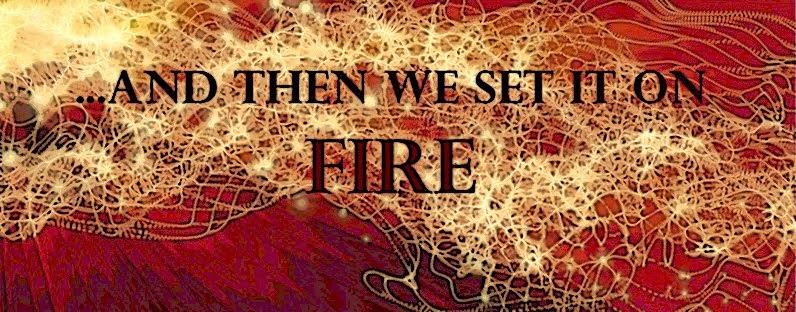This month has gone so quickly. Here it is our last Free For All Friday.
Let's start off with a piece from Marjee!
This was done using garbanzo bean and corn starch paste. I ironed the backside when it was nearly dry and that made the paste really hard so the cracks were sharp. The whole process was an experiment. The areas were blocked out using washable gel glue to wall in--or out--different colors of dye. Enjoying the blog. --
Marjee
And Ann Scott added in the comment section yesterday but I wanted to also post it here so no one would miss it. It is worth going back and seeing her piece posted yesterday after reading this additional comment.
One thing I forgot to mention about my piece is that the golden bits toward the bottom are painted fusible...another fun technique I like to use. -- Ann
Here are a couple of pieces sent in by Elaine Ross
We had a challenge in guild to do a quilt based on a book. I chose "Butterflies and Bottlecaps" which is about a young girl with butterflies for hair, who hates her hair and wishes she was normal. Her mother kept telling her "One day you will see how beautiful you are". So the girl met another girl with Bottlecaps for hair, each wished for the others hair...hence realizing they were beautiful in their own right. I say all that to show you I collected beer bottlecaps for months to use as embellishment. (My husband was only too glad to help.) I painted them to give a representation of hair color! --Elaine
Judy Sall sent in some examples as well this week
And here it is...one is a column of buffalo teeth!!
So...in recap...creating texture is an almost limitless method of adding interest and depth to your works of art. I hope this month has inspired you and gotten your creative brains to think even farther outside the box than most of them already do!
A special thanks to my three guest artists (and friends) Ann, Francie and Wil. You guys ROCK!! and made this month especially interesting for me and for all those who popped in for a visit. I can't thank you guys enough!
This has been a fun month for me! I hope it has been for you as well. This will be the last post and with it, I am wishing all of you to whom it means anything......a safe and happy Labor Day weekend!! And I will leave you with this link for your Moment of Texture. Click HERE to go to my Pinterest board entitled Tantalizing Texture. ENJOY!!!
Let's start off with a piece from Marjee!
This was done using garbanzo bean and corn starch paste. I ironed the backside when it was nearly dry and that made the paste really hard so the cracks were sharp. The whole process was an experiment. The areas were blocked out using washable gel glue to wall in--or out--different colors of dye. Enjoying the blog. --
Marjee
And Ann Scott added in the comment section yesterday but I wanted to also post it here so no one would miss it. It is worth going back and seeing her piece posted yesterday after reading this additional comment.
One thing I forgot to mention about my piece is that the golden bits toward the bottom are painted fusible...another fun technique I like to use. -- Ann
Here are a couple of pieces sent in by Elaine Ross
We had a challenge in guild to do a quilt based on a book. I chose "Butterflies and Bottlecaps" which is about a young girl with butterflies for hair, who hates her hair and wishes she was normal. Her mother kept telling her "One day you will see how beautiful you are". So the girl met another girl with Bottlecaps for hair, each wished for the others hair...hence realizing they were beautiful in their own right. I say all that to show you I collected beer bottlecaps for months to use as embellishment. (My husband was only too glad to help.) I painted them to give a representation of hair color! --Elaine
Judy Sall sent in some examples as well this week
These are fiber collages I made last year, and they are hung
on pieces of juniper wood I rescued from the wood pile. They are made
using water soluble stabilizer to hold everything together while I
stitched them to the backing. Great way to use many textures! -- Judy
And after some e-mail system issues, I was finally able to get examples from Wil Opio Oguta on the art piece she made using buffalo teeth. Mulberry bark I think is another texture element in this one. The title is "Treasures In The Sand". When doing a monochrome piece, often texture plays such an important role.
And here it is...one is a column of buffalo teeth!!
A special thanks to my three guest artists (and friends) Ann, Francie and Wil. You guys ROCK!! and made this month especially interesting for me and for all those who popped in for a visit. I can't thank you guys enough!
This has been a fun month for me! I hope it has been for you as well. This will be the last post and with it, I am wishing all of you to whom it means anything......a safe and happy Labor Day weekend!! And I will leave you with this link for your Moment of Texture. Click HERE to go to my Pinterest board entitled Tantalizing Texture. ENJOY!!!




















































.jpg)
%2B(2).jpg)

